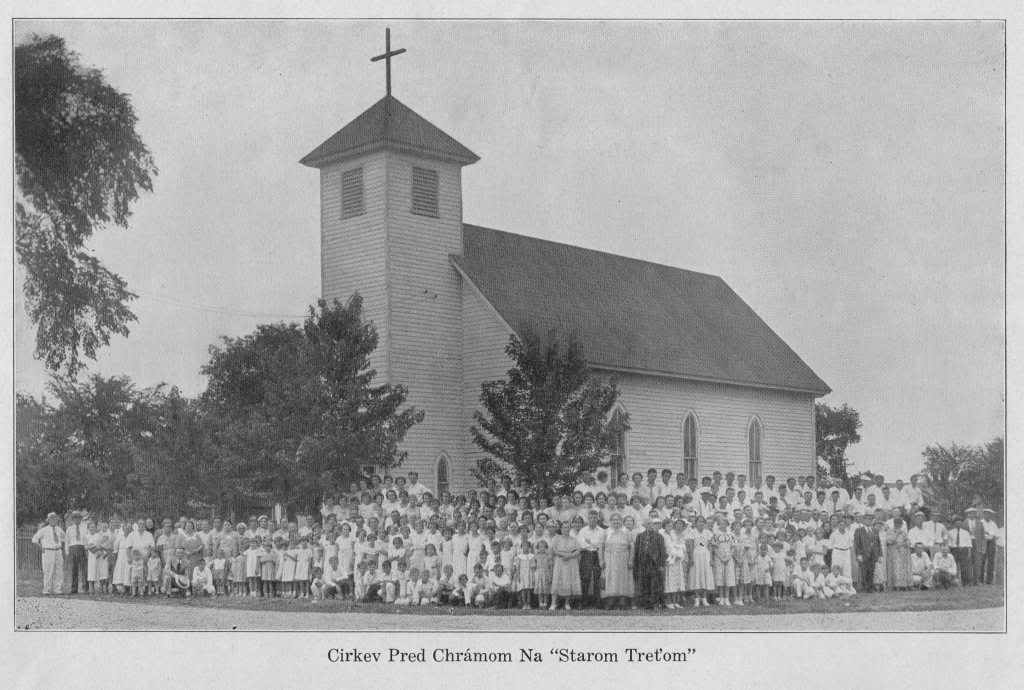Streator and Grandpa Sedory's Family
Every family consists of a father and a mother. In order to prove I was not hatched, I want to begin with my real-life father and mother: Dad and Mom (actually in later years she was always "Ma") lived in a town located about 90 miles or so southwest of Chicago: Streator, Illinois. They both were children of parents of Slovak descent.
[Editor's Note: There had been a friend or possibly distant relative of the family in Slovakia who rather than being dismayed by Magyarization (Slovaks expected to adopt Hungarian national identity and language), accepted it to the point of writing a book claiming that all the "Sedory" families living in Slovakia (there were quite a few at that time; both Lutheran and Roman Catholic) and many others with similar names, had Hungarian roots! And, of course, he wrote his book in Hungarian. Furthermore, although it can be shown that the surname Sedory in the USA could have been derived from its Hungarian equivalent; all official records at that time (from about 1844 to 1918) having been written in Hungarian (see explanation under Footnote 3 below), the name "Sedory" (with the same spelling we use here) could still be found in a 2005 Slovak phone book from the same area the Sedory families came from. So, our existing surname is one way it may have been spelled in Slovak; minus any possible accents! ]
Dad was the third oldest in his family, having a half brother George and a sister Anna who preceded him. George was the only child of Jur ("George") Novotny (Sr.) and Zsuzsanna ("Susanna" or "Susie") (Vanta)[1]; about 23 months into their marriage George Sr. died in a coal mine accident on September 23, 1890.[2] Susanna married George Sedory[3] at a later date [April 5, 1891; five months after George Novotny Jr. had been born].
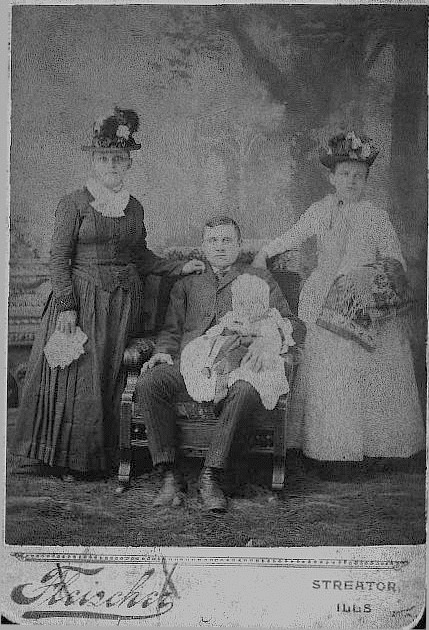 |
|
That marriage brought six children: Anna [3-27-1894; Anna Novotney], John ("Jack" - my Dad [October 24, 1896]), Mary [5-17-1899; Mary Post], Emma [4-30-1902; Emma Hritz], Susanna (1-7-1905; Sue Newby) and Margareta (6-29-1908; Margaret Brassfield). My Uncle George [or "Bill"] still carried the Novotny [no 'e'] name.
Editor's Note: Both the date and location of the following photo of George's Girls is unknown. However, Margaret appears (to this editor) to be no older than 3. If we assume it was taken at the end of June, 1911, Margaret would have just turned 3, and Anna would be 17 and atill single (she was married on September 9, 1912). Using those assumptions, I've added the ages for the Girls in parentheses. So (from Left to Right) we see Emma (9), Anna (17); Margaret (3) below Anna, their mother Susanna (42), Mary (12) and Sue (6):

(Photo scan provided by Matthew Schademann, 2016.)
The photo below shows all of George's family; except for Susanna's son, George ("Bill") Novotny. It was taken about 1917.
Back row: Emma and Mary; Middle: George, Margaret, Susanna; Front row: Sue (standing), Anna (sitting with her daughters, Viola and Evelyn—rubbing her eye), and John (your Editor's Grandfather):
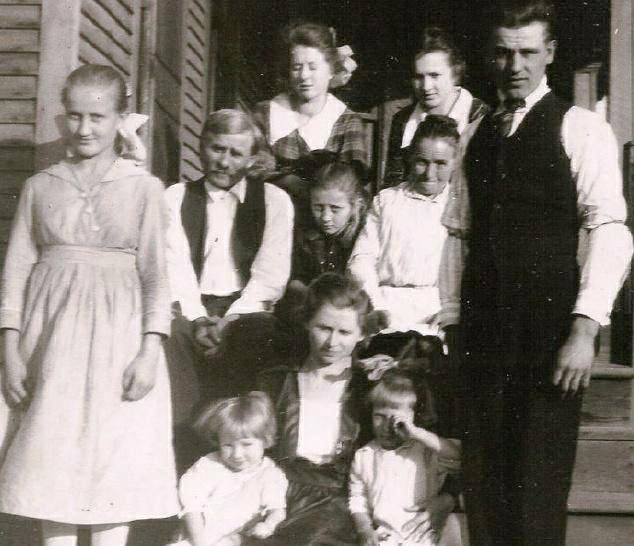
(From a copy of the original photo.)
This next photo had only "Around 1917 or 1918" on back. For the ages in parentheses, we've assumed a date of April 30, 1918.
Standing (Left to Right): George in uniform (27-1/2, known to his nephews and nieces as "Uncle Bill"), then Emma (16), John (21-1/2) and Sue (13-1/3). Seated: George (49-2/12) and Susanna (49-2/12), and kneeling in front, Margaret (9-10/12):
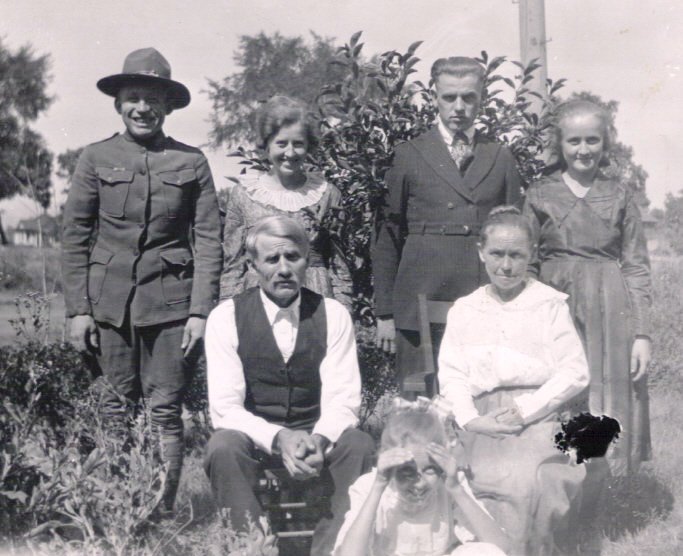
Note: Neither Anna (24-1/12) nor Mary (18-11/12) are in this photo.
Here's a photo of the author's father with all 5 of his sisters at a much later date [we're still attempting to set an exact date for this photo, but ages in parentheses are based upon March 27, 1964 for now]; from LEFT to RIGHT, Emma Hritz (62), Margaret Brassfield (56), John ("Jack" ) Sedory (68), Anna Novotney (70 that day!), Mary Post (65) and Sue Newby (59):

The Vagaskys
Mom was the eldest of four kids in her family: Mary [my Mom; December 9, 1903], Anna [3-7-1907; Anna F. Bazik], Elizabeth [3-25-1909; Elizabeth Dobrik] and the only boy, Thomas (Uncle Tom) [9-22-1915], all members of the Vagasky clan.
The following two pictures show the author's mother, Mary Vagasky (Far Right in first photo and 2nd from Right in second one) having some fun with a few of her friends at the "American Bottle Field" near the SantaFe RR tracks and Bronson Street in Streator, IL. If these were taken in the Fall of 1920, she would have been only 16 years old; about to turn 17 in December. And by Spring of the next year, she married my Grandfather at only 17.
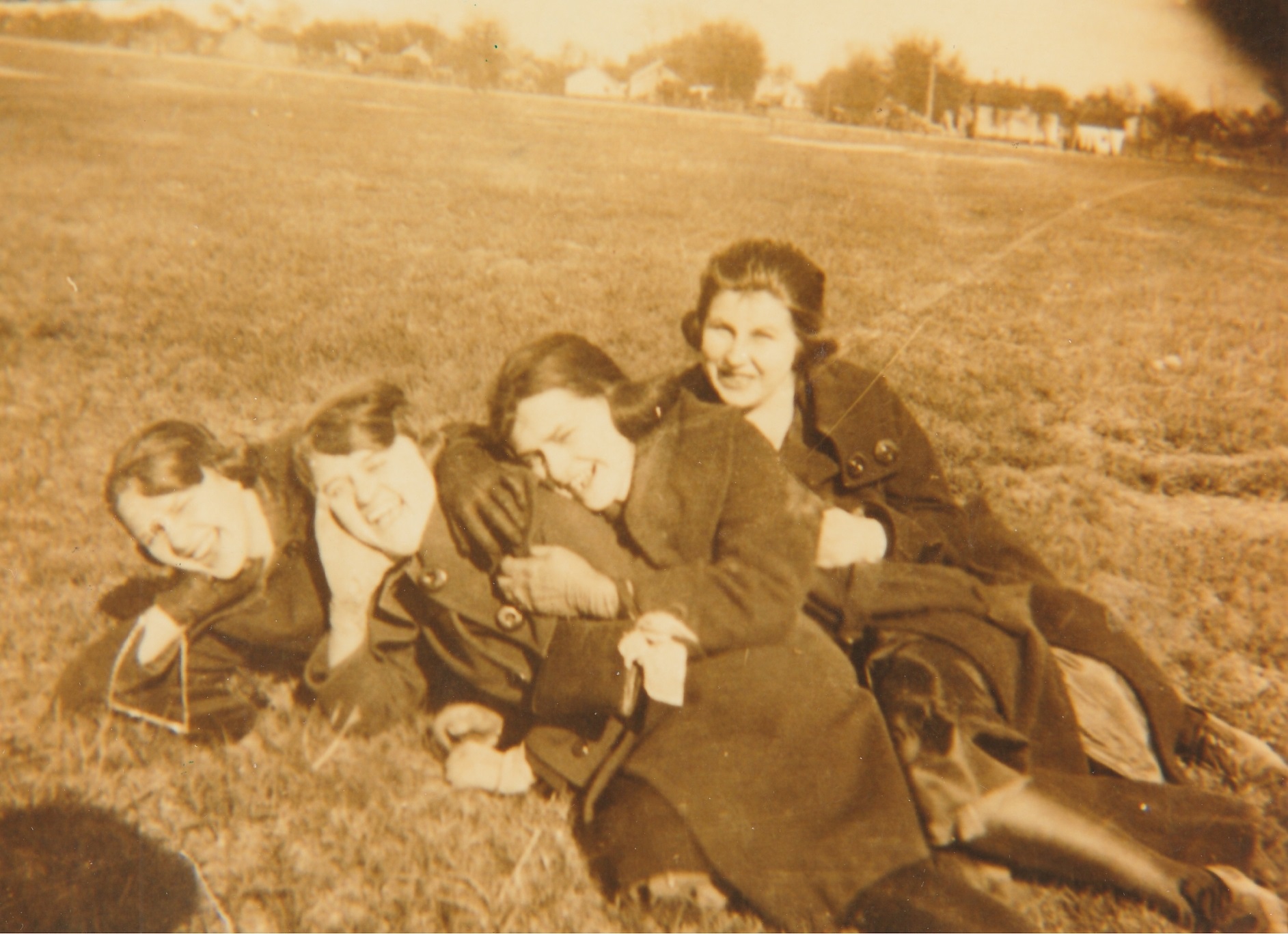 |  |
[Editor's Note: For anyone interested in the other 3 girls in these photos, here's what's written on the Back of the Car Photo. I've been able to identify the first one as: Mary M. “Bunsy” Harcharik Wargo Malik as she's listed on her memorial page. But I have no idea who the other two are yet.]
Mom and Dad's Marriage
Dad was seven years older than Mom. They both attended a Slovak Lutheran Church, as did all the family members. From what I can recall, they met at some sort of church affair, picnic or social perhaps. They must have hit it off, as they eventually married on May 26, 1921.
Early Siblings, Origin of Author's Name
Philip Andrew became the firstborn to John and Mary Sedory on November 6, 1921. Later, on March 29th, 1923, along came John Daniel, the trouble-maker who's writing this. Next came my sister Mary Elizabeth (who took on "Marie" later in life) on June 15, 1924. We were still living in Streator, Illinois, possibly now at a home our grandparents owned which was located on a lot adjoining their home.[4]
My name, John Daniel, was quite evident in its origin since the baptizing pastor was Reverend John Daniel,[5] pastor of the Slovak Lutheran Church in Streator.
Old Number 3
About ten years later [some people wanted to take] that old church ... to the Chicago World's Fair or The Century of Progress as it was called. The church was something like [50] years old and had historic value.[6]
I know I was either the last baptism in the old church or the first in the new one, a church which was either built new or bought as an existing building, I'm not certain. The old church was located in a section of town called "Old Number Three[7]." The newer one may have been in the "Painter's Addition" section, or at least near to it, since Grandpa and Grandma Vagasky lived in that section and weren't that far from it [about 1 mile SE of their home].
In Slovak, Grandpa and Grandma Vagasky were called "Dzedo" and "Baba" [Note: A recent Slovak dictionary, uses the word dedko for Grandpa, and babička or babka for Grandma; stating that baba is now derogatory, with 'old woman' being its nicest translation. However, in an online poll at a Slovak genealogy group, many there recall using baba for their grandmothers here in the USA.] In my many years of visiting there I never called them anything but those names, nor did my sister or brothers, as I recall.
Often Self-Conscious about His Nose
Since we lived in the house at the bottom of a slight hill, and since I was just a youngster, I was told for years that I often fell flat on my nose going up and down that hill. This was supposed to be where I got my larger, flatter nose. As much as I might have liked to believe that story, I'm afraid the truth to the matter is that I inherited it from my Dad's genes. We had almost identically shaped noses—something I considered less than flattery all my life, but something about which there was little I could do. Little, that is, outside of having had an operation in 1971 for a deviated septum and having some corrective surgery done to the shape of my nose as well. The problem with that surgery was that the doctor and my wife decided it wouldn't do to make my nose too small because of my larger face and features; and it turned out less than what I'd hoped for. It became a lot less flat on the tip, but in straightening it out, the surgeon extended it upward. So in reality it became longer, yet not all that small. Oh, well, that's the way it went and I can't change it. Maybe God knew I'd be too vain to handle looking as normal as most people do!
Slovak
You have to know something about our grandparents in order to appreciate some of the things I'll be relating to you. They were both of Slovak descent, from Slovakia. And that was their primary language for communication. In Streator this was no problem, for it seemed almost everyone spoke Slovak or Polish, which had some similarities. Or maybe it was just that the people I'd see while there on vacation were accustomed to speaking in their foreign tongue.
Later on in the book I want to relate many of my memories of those vacations at Baba and Dzedo's home at 816 Jackson Street, Streator, Illinois.
Grandma Sedory (1925)
You will notice I've concentrated on Dzedo and Baba Vagasky, while saying almost nothing about Dad's folks. The reason for this is the fact that Grandma Sedory passed away when I was very young [2 years old], so I don't remember her. She was supposed to be quite a woman!
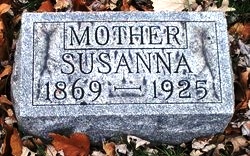
(Riverview Cemetery, Streator, IL)
[Editor's Note: The following is a story about the Author's Grandmother as he recalled it. However, relatives who grew up in families that remained in Streator for decades, have told me that although she may have had an accident in the kitchen at one time, her death was due to Tuberculosis (or what they called "Consumption" back then). I suppose someone may have attributed smoke from a fire as affecting her lungs, but TB is what actually took her life.]:
Grandma fell victim to a stove explosion, as I've heard the story told. [But he never said from whom.] Whether it was a coal, wood or oil fire, I don't know. She was supposed to have had her clothing and hair ignited from the blast, and I think the reason I don't know more about it is because I wanted to spare myself the agony of it all.
So Grandpa Sedory was alone, though other of his children lived close by, especially the Novotney family (Aunt Anna), who I think may have lived next door to him.
[Editor's Note: Only two houses (at 1318 and 1316) separate what was once the Novotney home at 1402 S. Bloomington Street (IL-23) and George's house at 1314 S. Bloomington Street in what is officially "Reading Township" (often called "South Streator") of "Livingston County" (e.g., for looking up US Census records).]
Another thing about Grandpa Sedory is the fact (hope I'm not wrong about this) he spoke very little English, making it difficult for us kids who spoke only English to communicate with him. [Editor's Note: Some family members say they don't believe this was true. Whatever his language abilities may have been at that time, I'm sure they improved as he grew older.]
In case this is incorrect data, it somehow just wasn't appropriate for us to spend vacations with him, while it was perfectly ideal for us to stay at the Vagasky's (Mom's folks).
[Editor's Note: Most likely it was simply a matter of his mother feeling more comfortable with them spending time with her own parents rather than an 'in-law'. I'm also sure his grandmother spoiled him more than a hard working man would have. I myself spent more time at my maternal grandmother's house than with any other relatives.].
Move to Chicago
Somewhere in the year after Marie's birth, the family moved to Chicago. The only reason I can think of for such a move was to provide better work opportunities for Dad. This was the beginning of changes that would follow [our move] to that city.
It had to be 1925, because the fourth sibling joined us there in Chicago on September 8th of that year. It was another boy, Edward Thomas. So now there were two younger and one older than I among us kids. What had already been a "job" in handling three kids now grew. Mom's time surely was well occupied, and Dad's responsibilities in providing for us also broadened.
The house in Chicago couldn't have been very large, and the living conditions evidently nothing to brag about, either; so we were off for another move! I doubt we lived there for more than a year or so. It also could have been that Dad located work at the
[Editor's Note: Some time in the summer of 1918, John "Jack" Sedory, who had turned 21 on October, 24th, 1917, had to fill out a 'draft card' for the second registration of WWI. We see he used a middle initial "J" for his name, and that he was employed at the "Streator Clay Works". This was, or at least started as (back in the 1890s or earlier), a mining company; with underground shafts. For the 1920 US Census, on January 28th, 1920, both John 'Jack' Sedory and his father George are listed as working at a "Brick Yard"; so our author's father already had brick yard experience before moving to Chicago.]
John ("Jack") Sedory's 1918 Draft Card:
Notice item 7 ("Father's birthplace") on the card above is give as: Austria. Prior to the end of WWI, Slovakia was part of the Austro-Hungarian Empire; which it appears was often shortened to simply "Austria" on various documents. As mentioned on our page about the family's 1920 census data,
the place where the Sedory family came from (near Sabinov, Slovakia), became part of a new country called the Czechoslovak Republic some time after WWI.
Foreword |
TOC |
Chapter A |
Footnotes
1[Return to Text] Not to be confused with the Novotney family (with an 'e') which the author's Aunt Anna married into. These are pictures of Zsuzsanna and Jur (likely short for Juraj which means "George") Novotny and of Jur's grave stone in Moon's Point Cemetery (sometimes incorrectly referred to as 'Moon Creek' cemetery):
 |  Family photo. |
2[Return to
Text] We do not have any records of which coal mine this occurred in. Concerning mine accidents in Streator, Paula Angle wrote:"Though Streator's mines never witnessed a major disaster, few weeks passed during the period between 1870 and 1910 without at least one fatality underground."
(Biography in Black, page 54.)
3[Return to
Text] Although they came to America from Slovakia, and the "Sedory" name is actually Slovak (as pointed out in the Editor's Note in the text above), it was written in its Hungarian equivalent in the book PÁL MESTER :: BAZINI ÉS SZENTGYÖRGYI GRÓF :: ANONYMUS by György Gusztáv Szentgyörgyi, which includes notes about our Sedory family purportedly being from a line of Hungarians, possibly even beginning with 'Master Paul'. On page 21 of the 1907 edition from Harvard, this genealogical tree contains references to my family in America (within the BLUE rectangle below):

John D. Sedory's grandfather is the "György (George) sz. 1869" (in BLUE); John's father being one of the 3 children born in America ("3 fiú született Amerikában"). In the 1908 edition, this note was changed to '5 children...'. The "János (John) sz. 1871" (in GREEN) also moved to America, married and had children in Pennsylvania. Robert J. Sedory (1926-2009), whose father was this János, provided us with a copy of the 1908 edition of this book; which can also be found here: A Hunt-Pázmán-, illetve Wettin-nemzetség története : kapcsolatban Pál mester, vagyis Anonymus (1908). (The tree is located on page 137 of 150 in this online reader.)
1 György Szegyory (George Sedory; 1843-1890); see: Wikitree Profile for Szegyory-3.
2 György Szegyory (George Sedory; 1869-1938); see: Wikitree Profile for Szegyory-2.
3 János Szegyory (John Sedory; 1871-1926); see: Wikitree Profile for Szegyory-4.
4 István Szegyory (Steven Sedory; 1878-?); see: Wikitree Profile for Szegyory-5.
5 János Szegyory (John Sedory; 1845-?); see: Wikitree Profile for Szegyory-6.
The surname Sedory is both an actual Slovak spelling and an anglicized version of its Hungarian equivalent, Szegyory. Hungarian has seven letters (in its 38-letter alphabet) called digraphs. These letters have been represented for a long time by two characters each from the Latin alphabet. They are: cs, gy, ly, ny, sz, ty, and zs (as we've seen in 'Zsuzsanna'). In Hungarian, sz is pronounced like a regular English s as in 'sell', never like a z as in 'rose' and gy is pronounced like dy, or the d in 'adulation'. At this point it should be clear how Sedory, came from Szegyory. This name, however, is closely related to, and simply a shortened form, of a longer and much more common name in Hungarian: Szentgyörgyi, or Szent-György. The word, "Szent," in such names, would mean, Saint, and "György" is a Hungarian form of the given name George. Thus, the name means Saint George. As a matter of fact, the phrase Szent György kereszt is how the "Red Cross" organization is known in Hungary! In other words, its literal meaning there is: Cross (or Crest) of St. George. So, 'Sedory' can, in a rather round about way, also be thought of as meaning 'Saint George'. |
4[Return to
Text] Just like the author, we cannot be certain whether he was living inside his Grandfather's house or in one next to it at the time. Or, which may actually make more sense: They were living with his mother's parents at 816 Jackson Street (also in Streator, IL), since after reviewing the facts, we must note the author did not specify which "grandparents" home!
The facts we have are as follows: 1) During the 1920 US Census for George Sedory ("Head"), his wife Susie, their children John(23; author's father), Mary(20), Emma(17), Susie(15), Margaret(11), and Anna(25) and her husband Andrew(29) and their children Evelyn(6) and Viola(4-1/12) were all living in the same house! (Note that the enumerator listed Andrew as "Son in law"; not 'head' of a house.)
2) During the 1930 US Census for George Sedory ("Head")(61); with his last name either incorrectly indexed or written as "Sedary," George had his daughters Mary(30) and Emma(27) and Emma's husband Paul Hritz(31; incorrectly indexed as 'Baritz' and listed as "Son in law") living with him, but looking at the family listed under the previous "Head" entry on the same sheet, you'll find "Andrew" Novotney incorrectly recorded as "Novatny," and his wife Anna(36) and children, Viola(14), Phyllis(8), Richard(6), Marie(4-3/12) and Robert(11/12). (Unfortunately, no house numbers nor even street names were recorded by this enumerator!)
3) So, some time between 1920 and 1930, the growing family of Andrew and Anna Novotney moved into another house, but whether it was before or after the author's parents (who didn't have any children until 1921) decided to move to Chicago (in 1925), we cannot say for sure at this time.
4) Further research is required to determine if Andrew Vagasky had a home next to him in the early 1920's which the author's family may have been living in, or 5) They were living with the Vagasky family at that time.
5[Return to
Text] As an example of multiple non-related "Sedory" families in Slovakia, we note here that pastor John Daniel's wife had been born Anna Sedory in Chicago, and her father (Andrej / Anton / Andrew Sedory) actually came from the same small village ("Orkucany") in Slovakia that ours did (according to this church record), yet we know of no common ancestor. It should be noted, however, that his father's surname is listed here as "Surgent - Sedory"; not simply Sedory or Szegyory:

6[Return to
Text] The editing above is due to the author having incorrectly believed the old Slovak church was actually brought to the Chicago World's Fair; it was not. [More will be said about the 1933 World's Fair in Chapter 13.] (The author had also written, "the church was something like 100 years old," but having been built in 1884, it was only 49 years old in 1933.) Most likely his parents heard from relatives that it might happen, and he believed that it did. However, the facts are:
"The historic Slovak Lutheran church ... was the object of much attention recently on the part of Century of Progress officials. They sought to have it moved to the World's Fair grounds in Chicago, but Merrimack [a founder of the church] objected vigorously, and the request was denied." [Streator Daily Times-Press, Tuesday, March 14, 1933]
For notes on its "historic" value, see the next footnote (#7).
7[Return to
Text] Odd as it may seem, these are actual references to parts of Streator as noted in this historical work:"Reflecting the trend of general United States immigration at this time, many of Streator's newcomers were from central and eastern Europe, particularly Poland and Slovakia. Many Slovaks clustered together in Painter's Addition, to the northeast. Both Poles and Slovaks settled on the southern edge of town in the Vermillion City area (at this time generally known as "Old Number 3," after a CW&V [mine] shaft, or as South Streator). The oldest Slovak Lutheran church [building] in America was built in this neighborhood, just west of Bloomington Street, in 1884." [Biography in Black: A History of Streator, Illinois by Paula Angle (1962), p. 44.]
(You can download "Biography in Black"
from its archive.org link as PDF, text, etc.)
The exact location of this building is at the NE corner of Church and Franklin Streets; just west of South Bloomington St. (Hwy. 23), as seen on this Waymark page. Or, notice all the tall trees covering its roof in this Google satellite view. Here's an old picture of the church (the people) and their building from a postcard of that era:
8[Return to
Text] Only later (in Chapter 9) does the author identify the 'brickyard' as being run by the "Brisch Brick Company". But he also describes areas he and his brothers would frequent in and around the brickyard in Chapter 6.
Foreword |
TOC |
Chapter 2 |
